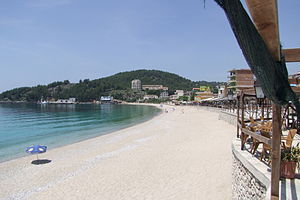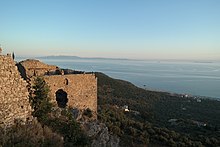Himara
|
Himarë Himara |
||

|
||
|
Coordinates: 40 ° 6 ′ N , 19 ° 45 ′ E |
||
| Basic data | ||
|---|---|---|
| Qark : | Vlora | |
| Municipality : | Himara | |
| Height : | 90 m above sea level A. | |
| Area : | 571.94 km² | |
| Bashkia residents : | 5738 (2011) | |
| Population density (Bashkia): | 10 inhabitants / km² | |
| Telephone code : | (+355) 393 | |
| Postal code : | 9425 | |
| Politics and administration (as of 2019 ) | ||
| Mayor : | Jorgo Goro ( PS ) | |
| Website : | ||
 Himara Beach (2009) |
||
Himara ( Albanian also Himarë; Greek Χειμάρρα Chimárra ) is a small town on the coast of the Ionian Sea in southern Albania in the Qark Vlora . It is the political and economic center of the Albanian Riviera , the remote stretch of coast north from Saranda to the Adriatic Sea . The Himara Bashkia encompasses the entire Riviera, which is why Himara often means more than just the place.
geography
Himara is very remote and separated from the rest of the country by the Ceraunic Mountains . The national road SH8 along the coast is very winding. Buses take a long time to get to the Qark capital Vlora via the Llogara Pass . Only in the summer occasionally run regular boats to Corfu and Vlora. Merchant ships rarely call at the port. Thanks to the seclusion, the nature around Himara is still relatively untouched.
The new district of Himara is located directly on the seashore in a long bay with a sandy beach. Old Himara lies a little inland on a hill. It is characterized by old stone houses and steep, narrow and therefore car-free streets. There is groundwater on the hill, and attacks from the seaside were easier to defend against. That is why a settlement was established here in ancient times. The castle with its church is in ruins today.
The entire Riviera has been part of the Bashkia area since 2015. Until 2015, only the northern part of the coast belonged to Bashkia, next to Himara the villages Palasa , Gjileka , Dhërmi , Ilias , Gjipa , Vuno , Jala , Pilur and Kudhës . The population of the municipality was 2822 people (2011 census). Local sources give a much higher number of 11,250 inhabitants (2004); about half of them live in the city of Himara. In 2015 the municipalities of Lukova with the villages of Çorraj , Borsh , Piqeras , Shënvasil , Fterra , Qazim Pali , Nivica and Sasaj , which had 2916 inhabitants, as well as Horë-Vranisht with the villages of Vranisht , Kuç , Kuç Buronja , Bolena , Kallarat and Tërbaç and 2080 inhabitants incorporated. The new municipality has a total of 7818 inhabitants (as of 2011).
Greeks and Greek language
Members of the Greek minority live in Himara . Exact figures on the distribution of the population groups are not available. The inhabitants of the villages of Himara, Dhërmi and Palasa still communicate mostly in Greek on a daily basis, while Albanian is the main language spoken in Ilias, Vuno, Qeparo, Kudhës and Pilur.
While the Albanian language predominated in the public during the communist era, there has been a marked renaissance of Greek in Himara over the past decade. Labor migration to Greece plays a major role in this . The migrant workers from southern Albania, some of whom return to their homeland several times a year, some only in summer, also bring Greek influences with them.
The language question in Himara repeatedly leads to scientific disputes and political tensions. Greek and Albanian historians disagree as to whether the Greek minority is long-established or not. Politically, it is about the question of whether Himara receives the status of a minority community. Incidents occurred in Himara during the 1999 and 2003 elections because the Greek minority felt disadvantaged. In the spring of 2009, a court in Vlora sentenced the Greek mayor to several months' imprisonment after he had street signs that were only written in Albanian removed at the end of 2007. Tensions escalated in the summer of 2010 with the murder of a Greek-born resident .
There has been a Greek school in Himara since 2009.
history
A settlement was established in pre-Roman times. Both their name and the origin of the first inhabitants of Himara (perhaps Chaoners , Illyrians from another tribe or Greek colonists from Corfu ) are unknown. In the 2nd century BC The area was conquered by the Romans and initially added to the province of Macedonia . During the civil war , Julius Caesar's army moved from Oricum past Himara to Greece, after landing a few kilometers north. With the final division of the Roman Empire (395), Epirus and with this region also Himara fell to the Greek-influenced Eastern Empire.
Even from the Middle Ages, there is little reliable information about Himara. For some time the place was the seat of an Orthodox bishop , as such Himara is attested in 1020 in a Byzantine document. For most of the time, Himara was on the border of various rival empires. As a result, the place was able to acquire a certain autonomy . At the end of the 9th century, the Bulgarian Empire reached as far as the coast of Himara. In 1085 the Normans devastated the area.
After the 4th Crusade , the rule of Byzantium on the Ionian Sea collapsed. The successor state was the despotate Epirus , whose eventful fate Himara shared until the second half of the 13th century. Since that time the Himariotes maintained their own fleet, which they used to protect their territory as well as for piracy . Himara herself was strongly fortified. Presumably in 1277 Himara came under the rule of the Napoletan king Charles of Anjou. Since around 1375 Himara belonged to the possession of the Ballsha , but they could only assert themselves as city lords for 20 years.
At the end of the 14th century, the Ottomans began to conquer Christian rule in what is now southern Albania. By 1420 the whole region - apart from Himara and the Venetian Butrint - was under Turkish control.
In 1481 the Himariots revolted against the Ottomans, who only nominally exercised supremacy over Himara. With their fleet they disrupted the Turkish supply to Otranto , Italy , which was briefly occupied by the Turks that year. The armed unrest of the Himariots against Ottoman rule lasted until the beginning of the 16th century. In 1492, after an unsuccessful campaign , Sultan Bayazid II even found himself ready to an agreement in which the Himariots were granted autonomy. Sultan Suleyman attacked Himara again in 1537, which at that time ruled about 50 villages in the area. Even if the Himariots could not hold their ground against the Turks in the long term, the Ottomans' rule over the region, which was almost only accessible by sea, remained weak.
In 1798 Tepedelenli Ali Pasha captured Himara and incorporated the city into his rule. He built the fortress Porto Palermo in a sheltered bay south of Himara . With the death of Ali Pasha in 1822, Himara came back under the rule of Istanbul. In 1833 the Himariots took part in an anti-Turkish uprising. In 1912 Himara became part of independent Albania. In the interwar period, Himara was at times a separate subdistrict within the Vlora prefecture . In 1940 the Greek army advanced as far as Himara.
On May 21, 2012, a serious bus accident occurred at Himara, in which 13 students, including 11 female students, were killed and 20 others were seriously injured. The tour bus came off the road between Vuno and Himara for unexplained reasons and fell 80 meters into a ravine. The students from Elbasan University were on a trip to Saranda to celebrate their graduation.
Attractions
A few kilometers south of Himara in the bay of Porto Palermo on a small peninsula is a fortress that is said to have been built by Tepedelenli Ali Pascha at the beginning of the 19th century. It can be assumed, however, that it is much older and was probably built by the Republic of Venice around the same time as the similarly constructed fortress in Butrint .
Also there, in a restricted military area, but clearly visible from the fortress and the coastal road, is a former Soviet and Albanian submarine base with a submarine bunker driven into the rock .
Qeparo and Borsh have pretty castles.
economy
Himara and the neighboring villages - especially Dhërmi - are popular holiday destinations for Albanians from home and abroad. Numerous apartment houses, restaurants and shops have sprung up in recent years. Despite everything, the infrastructure is still modest and can hardly cope with the onslaught of tourists in summer.
Outside of the holiday season there is little going on in and around Himara. Almost all of the old people live in the villages - many young people work and live in Greece. Besides agriculture and tourists in summer there are hardly any sources of income. The few factories have been closed and the naval base of the Albanian Navy is half abandoned. Fishing is hardly worthwhile because the distribution channels would be too far.
sons and daughters of the town
- Neço Muko (1899–1934), iso-polyphonic singer
- Pyrros Dimas (* 1971), weightlifter
- Sotirios Ninis (* 1990), football player
literature
- Kristo Frashëri: Himara dhe përkatësia etnike e himarjotëve. Bisedë me historianët grekë. Tirana 2005. ISBN 99927-1-951-6
- Peter Bartel & Martin Camaj: On the topography and history of the Himara landscape in southern Albania. in: Münchner Zeitschrift für Balkankunde, Vol. 7–8., Munich 1991, pp. 311–354
- Rami Memushaj: Himara - Në dritën e të dhënave historike, gjuhësore dhe etnologjike. Tirana 2004. ISBN 99927-1-797-1 review (Albanian)
- Spiro Rusha: Himara në stuhitë e shekujve. Tirana 2001.
- Kostas Chatzeantoniou: Chimara. To aparto kastro tes Voreiou Epeirou. Athens 2002. ISBN 960-8275-01-6
Web links
- official homepage
- Karen Francis: The Lost Caves of Luigi Cardini. Exploration in Albania 1930-2001. (with a section on Himara)
Individual evidence
- ↑ Ines Nurja: Censusi i popullsisë dhe banesave / Population and Housing Census - Vlorë 2011 . Results Kryesore / Main Results. Ed .: INSTAT . Pjesa / Part 1. Adel Print, Tirana 2013 ( instat.gov.al [PDF; accessed April 14, 2019]).
- ↑ a b Nataša Gregorič: Contested Spaces and Negotiated Identities in Dhërmi / Drimades of Himarë / Himara area, Southern Albania . Nova Gorica 2008 ( text online [PDF; 2.2 MB ; accessed on February 25, 2013]).
- ^ TJ Winnifrith: Badlands - Borderlands, A History of Southern Albania / Northern Epirus , Duckworth, London 2002, ISBN 0-7156-3201-9 , p. 154
- ↑ James Pettifer: Albania & Kosovo - Blue Guide , A & C Black, London 2001, ISBN 0-7136-5016-8 , p. 476ff
- ↑ Ethnic Greek's murder in Himare sparks protests, Athens reaction. In: SManalysis. August 14, 2010, accessed August 16, 2010 . , Ethnic killings in Himare. In: SManalysis. August 13, 2010, accessed August 16, 2010 .
- ^ Human Rights Watch World Report 2001: Albania
- ↑ Entela Stamati: The apple of discord between Albania and Greece: the recent electoral campaign on the Albanian riviera . In: SouthEast Europe Review for Labor and Social Affairs . No. 1 , 2004, p. 139–141 ( full text (PDF) ( Memento of December 12, 2011 in the Internet Archive )).
- ↑ Albania: Greek Mayor Sentenced to Prison. In: BalkanInsight. April 21, 2009, accessed September 14, 2012 .
- ^ The Greek school in Himara opens for children. Retrieved September 21, 2009 .
- ↑ Tragjedia në Himarë, 13 viktima. In: Top Channel . May 21, 2012, Retrieved May 23, 2012 (Albanian).





